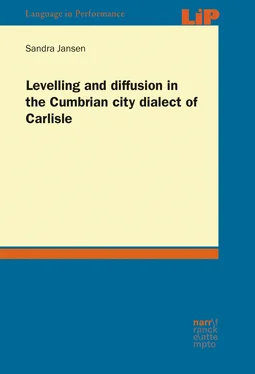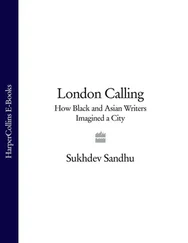Sandra Jansen - Levelling and diffusion in the Cumbrian city dialect of Carlisle
Здесь есть возможность читать онлайн «Sandra Jansen - Levelling and diffusion in the Cumbrian city dialect of Carlisle» — ознакомительный отрывок электронной книги совершенно бесплатно, а после прочтения отрывка купить полную версию. В некоторых случаях можно слушать аудио, скачать через торрент в формате fb2 и присутствует краткое содержание. Жанр: unrecognised, на английском языке. Описание произведения, (предисловие) а так же отзывы посетителей доступны на портале библиотеки ЛибКат.
- Название:Levelling and diffusion in the Cumbrian city dialect of Carlisle
- Автор:
- Жанр:
- Год:неизвестен
- ISBN:нет данных
- Рейтинг книги:5 / 5. Голосов: 1
-
Избранное:Добавить в избранное
- Отзывы:
-
Ваша оценка:
- 100
- 1
- 2
- 3
- 4
- 5
Levelling and diffusion in the Cumbrian city dialect of Carlisle: краткое содержание, описание и аннотация
Предлагаем к чтению аннотацию, описание, краткое содержание или предисловие (зависит от того, что написал сам автор книги «Levelling and diffusion in the Cumbrian city dialect of Carlisle»). Если вы не нашли необходимую информацию о книге — напишите в комментариях, мы постараемся отыскать её.
Levelling and diffusion in the Cumbrian city dialect of Carlisle — читать онлайн ознакомительный отрывок
Ниже представлен текст книги, разбитый по страницам. Система сохранения места последней прочитанной страницы, позволяет с удобством читать онлайн бесплатно книгу «Levelling and diffusion in the Cumbrian city dialect of Carlisle», без необходимости каждый раз заново искать на чём Вы остановились. Поставьте закладку, и сможете в любой момент перейти на страницу, на которой закончили чтение.
Интервал:
Закладка:
2.2 Regional identity
Above, geolinguistic processes that potentially lead to language change as set out by Trudgill (1986) have been discussed. The section on accommodation clearly shows that these processes must have their beginning at the individual speaker level. However, on the macro level the discussion on diffusion is not complete without considering the social motivation within a community for change triggered by identity constructions. Torgersen and Kerswill (2004: 25-6) emphasise that internal and external as well as extra-linguistic factors have to be taken into account for the analysis of changes within a community that are observed across a larger geographical area. These extra-linguistic factors lead to “locally specific outcomes” (Watts 2005: 26). For Britain (2010b), these extra-linguistic factors are part of the spatial practice of the community. Nevertheless, they all agree that factors which lie outside of the linguistic system of a community can and do influence linguistic choices. It is important in which (physical and emotional) direction people orient themselves as a community. This extra-linguistic behaviour should be taken into when investigating the linguistic behaviour of speaker groups. However, spatial practice is often only partially responsible for variation and change processes.
In particular in the north of England, several studies have shown that the attitude of speakers can have an influence on linguistic change (cf. Watt 2002; Burbano-Elizondo 2006; Llamas 2007). Britain (2010b: 203) calls for attention to the social practice of the speakers. Positive and negative associations with other regions can have linguistic repercussions, e.g. Llamas (2007) sketches the historical development of the city of Middlesbrough with various cases of geographical reorganisation which is reflected in political, social and perceptual views of the speakers. Nevertheless, these social practices have repercussions on the linguistic choices of the speakers, repercussions which sociolinguistic studies are trying to detect.
2.3 Dialects in contact: The Carlisle setting
The discussion in this chapter has provided an overview of the mechanisms of dialect contact situations that are relevant in various speech communities. The present study is based on the dialect contact framework. Britain (2010b) argues that the increase of mobilisation has led to the increased contact between people with different dialects. Hence, he claims that this rise in contact situations has led to an advanced stage of levelling in Britain. While his argumentation is true for most contact situations which evolved due to better transportation or mobility across long distances, Carlisle is a microcosm in its own right. Increased mobility certainly plays an important role. People frequently commute to Carlisle from Scotland but also from West Cumbria and Northumberland and other surrounding areas, all of which have quite distinct dialects. Indeed, the geographical position of Carlisle could also have an influence on language choice in Carlisle.
Carlisle is also the city in England which is furthest away from London and the south-east, the area where many of the features subject to consonantal diffusion seem to origin. One aim will be to research diffusional patterns in Carlisle English. Therefore, the description and analysis of features which are diffusing to the city or which are varying between speaker groups can provide us with information about the distribution of these diffusional features as well as sociolinguistic information about the social make-up of the city.
Recently two major projects have involved Carlisle as an object of research. Montgomery (2006) takes a perceptual approach to geographical variation with one of the fieldwork sites being Carlisle. He finds that people in Carlisle recognise their accent when it was played to them but when they were asked to place the accent on a map they placed it as far away as possible from the actual setting of Carlisle. He argues that because the people do not like the accent they react this way.
A second study which focuses on the dialect of Carlisle English is conducted by Llamas et al. (Accent and Identity on the Scottish-English Border (AISEB) 2008-2011). They are concerned with ‘border identities.’ In their project, speech in Carlisle and three other towns along the Scottish-English border are analysed in terms of linguistically converging and diverging trends between border towns. For this project, data was collected in four towns in close proximity to the Scottish-English border: Greta (Scotland) and Carlisle (England) in the west and Eyemouth (Scotland) and Berwick-upon-Tweed (England) in the east.
This study sets out to investigate language variation and change in the Carlisle dialect. As has been noted above, Northern England has received a lot of linguistic attention. Nonetheless, Carlisle English and the far north-west have so far been largely neglected. In particular the Tyne and Tees area, Liverpool and Sheffield (cf. Beal and Corrigan 2002; Watson 2006; Llamas 2007; Beal, Burbano-Elizondo and Llamas 2012), places that are frequently embedded in larger urban conurbations, are regularly the subject of linguistic studies. However, until recently little was known about the Carlisle variety of English, a city without an immediate urban neighbourhood. Description work on major accents and dialects such as Wells (1982: 350f) hardly discuss or offer examples for a Cumbrian or Carlisle accent.
For the Carlisle dialect in particular only one source of data was available up until recently. Peter Wright’s (1978) description of the Carlisle dialect was the only attempt to approach this urban area linguistically. This short study is not systematic and it is written in a rather popular style. He describes the features which are salient to him using semi-phonetic spelling which leaves room for interpretation. He claims that “although Cumbrian towns and villages are singularly lucky in retaining so well many aspects of their traditional vernacular, Carlisle should never be forgotten” (Wright 1978: 7). With this statement he illustrates the dilemma of the Carlisle dialect. He hints at a handful of studies that have been conducted in the far north-west, especially in the former county of Westmoreland. For example, Reany (1927) deals with grammatical aspects of the Penrith dialect (Penrith is 36 km south of Carlisle), Brilioth (1913) focuses on the grammar of Lorton in Cumberland (Lorton is 55 km south-west of Carlisle) and Rydland (1978) investigates the dialect use of south-west Cumbria. However, no one has conducted a systematic study of the Carlisle dialect.
Only lately have linguists started to comment on this desideratum. Beal (2008) argues that there are certain areas in Northern England which have not been covered in sociolinguistic and dialectological terms and Carlisle is one of them. Wales (2008: 172) comes to the same conclusion: “Manchester, the ‘capital’ of the north in the nineteenth century, Leeds and Bradford with their significant minority group populations, Lancaster and Carlisle, […], all await investigation.” Since then a number of studies on the Carlisle dialect have been conducted, e.g. Jansen (2015a); Jansen (2015b); Jansen (2017a); Jansen (2017b).
3 Carlisle and its geographic, historic and sociolinguistic background
The aim of this chapter is to provide information about the geographic and demographic background as well as the historic development of Carlisle as an urban centre in the north of England in order to ascertain important developments which have had and still have repercussions on the linguistic development of Carlisle English.
3.1 Geography
The county of Cumbria was created in 1974 after the Local Government Act (1972) by combining the historical counties Cumberland, Westmorland and Furness, formerly a part of Lancashire. The county is divided into six districts: Allerdale, Barrow-in-Furness, City of Carlisle, Copeland, Edenund South Lakeland. After North Yorkshire and Lincolnshire, the county is the third largest non-metropolitan county in England. Neighbouring counties of Cumbria are Northumberland, County Durham, North Yorkshire, Lancashireand the Scottishcouncil areas of Dumfries, Gallowayand Scottish Borders. To the west there is the Irish Sea with the Solway Firth. The Lake District in the south of the county is a tourist attraction of which Carlisle as the largest and only city in Cumbria can only partially benefit. Carlisle is not a typical holiday destination but more of a stop off city.
Читать дальшеИнтервал:
Закладка:
Похожие книги на «Levelling and diffusion in the Cumbrian city dialect of Carlisle»
Представляем Вашему вниманию похожие книги на «Levelling and diffusion in the Cumbrian city dialect of Carlisle» списком для выбора. Мы отобрали схожую по названию и смыслу литературу в надежде предоставить читателям больше вариантов отыскать новые, интересные, ещё непрочитанные произведения.
Обсуждение, отзывы о книге «Levelling and diffusion in the Cumbrian city dialect of Carlisle» и просто собственные мнения читателей. Оставьте ваши комментарии, напишите, что Вы думаете о произведении, его смысле или главных героях. Укажите что конкретно понравилось, а что нет, и почему Вы так считаете.











